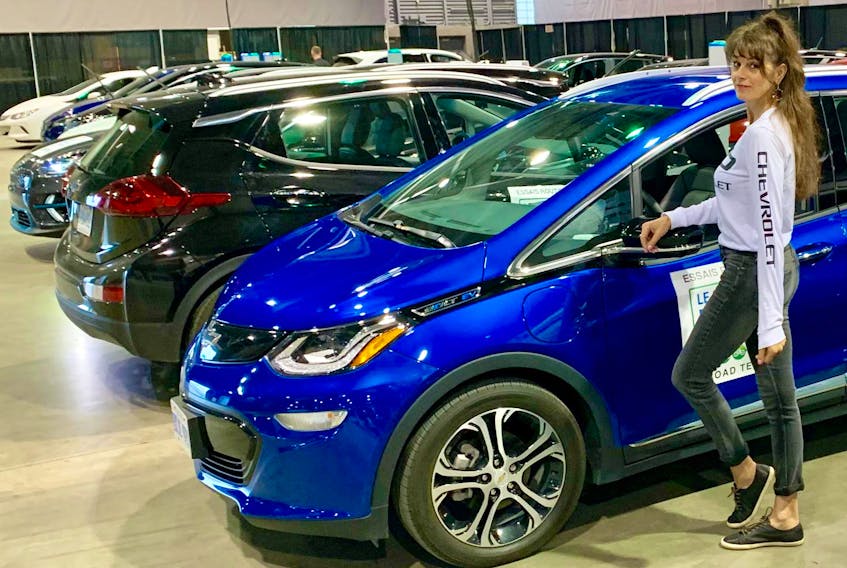A few days in a resort on the shore of Lac Beauport, 15 kilometres north but a world away from downtown Quebec City, was a proper place to recharge mind and body.
The only caveat was the 10 hour-a-day commitment to help out with the ride and drive sessions at Quebec City’s Salon du véhicule électrique, the city’s first public exposition dedicated entirely to everything electric vehicle.
Electrically powered cars, bicycles, scooters, ATVs and boats were all there, along with displays of charging stations, information booths on incentives and technology kiosks.
Oh well, just get up early, watch the sun slowly rise over the lake and make sure holidaying is done by nine each morning. After breakfast, drive to the show and get ready for hours of tech-talk and fellowship while riding shotgun in an electric car with complete strangers. It might be a stretch for the word fellowship, but the 15-minute forays onto freeways and city streets were an interesting way to spend the days.
With a growing number of people bent on experiencing wheel time in an electric vehicle, there was no shortage of participants. Even though my capabilities in French are pathetic, it didn’t take long to realize most of the folks I was coaching through the drive were contemplating throwing off the yoke of fossil fuel-powered vehicles.
The province of Quebec, rife with low-priced hydro electric power, makes it a hot spot for the escalating electric vehicle market. Federal and provincial rebates up to $13,000 sweeten the pie.

Electric motors have been around since the early 1800s. It was Scottish inventor Robert Anderson who assembled the first crude electric horseless carriage, powered by a non-rechargeable battery, as the race for self propelled vehicles intensified.
By the end of the 19th century the advent of the internal combustion engine sidelined electrically powered road vehicles leaving them in the dust and smoke of carburetors, fuel tanks, and carbon dioxide waste.
My first experience with an electric vehicle was running a series of mobility tests on a Marathon C-300 electric car for the Canadian Armed Forces in the mid 1970s. The Marathon was a primitive car; essentially a bloated golf cart powered by a bank of 12 hefty six-volt automotive batteries.
With a range of only 50 kilometres and top speed of 60 km/h, the sloppy handling, crude but cute machine did little to compel anyone into believing electrically powered cars would ever become viable.
Checking out the clientèle at Quebec’s Salon du véhicule électrique, it was easy to see what 50 years of progress and education has brought. We have passed the tipping point and all vehicle manufacturers are hot on the trail of satisfying consumers looking for a viable alternative to the internal combustion engine.
The people I met from all over the province were full of questions and stories about why they were considering an EV. One had a Ford F350 to haul their camper around but felt so guilty he wanted to go electric as a kick-back to the environment. Some told me they wanted to set an example for their children and grandchildren. Others simply wanted to feel what an electric car felt like to drive.
I’ve worked around a lot of vehicle shows and what is different about an EV show is the attendees show up with more of a purpose than a dream. They want answers. How far on a charge? How long does it take to recharge? How much does it cost and what are the incentives and rebates?
The electrification of the transportation system is well on its way. As I watched the fleet of 21 EV ride-and-drive vehicles slip silently into and out of the convention centre, it all seemed so futuristic.
Automobile manufacturers can obviously build reliable cars and trucks. They know how to improve fuel efficiency with lower coefficients of drag, installing low rolling resistance tires, utilizing improved lubricants and educating drivers on fuel-saving driving techniques.
Hybrid technology has helped with regenerative braking technology and most new vehicles have idle cut-off systems to conserve fuel when stopped at traffic lights.

The electric motor has evolved over the past two centuries and has now been adapted for automotive use by most manufacturers. Over the next decade, aside from building a charging network with stations as ubiquitous as gas stations, the battery will be the focus. Making it lighter, smaller, quicker to charge and less expensive will continue to pave the road for a massive global shift to electric vehicles.
Times are changing out on the road, and after a three-day weekend living with electric cars and the people who will be buying and driving them, I’m even more convinced of that.
Follow Garry on Instagram: @garrysowerby









